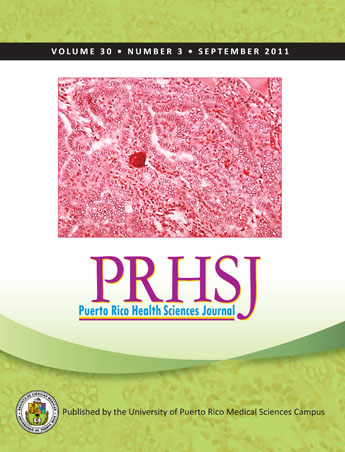Abstract
Objective: Children with type 1 diabetes have infrequently been the subjects of studies examining oral health status (caries and gingival diseases); in addition, no study of this type has ever been on Puerto Rican children. The purpose of this study was to evaluate the oral health status of Puerto Rican children (ranging in age from 6 to 12 years) either with or without type 1 diabetes and compare the two groups with regard to that status. Methods: This was a matched case-control study. A convenience sample of 25 children with type 1 diabetes (cases) and 25 non-diabetic children (controls), all ranging in age from 6 to 12 years and matched by age and gender, was evaluated by a calibrated dentist for caries, bleeding on probing, and plaque and calculus indexes. A sample of saliva was taken from each subject and analyzed to determine Streptococcus mutans and Lactobacillus counts. Descriptive statistics, chi-square test, and t-test were used to describe and assess the data. Results: We used the caries index to evaluate the teeth of the children participating in our study; we found significant differences in the number of lesions in the permanent teeth of diabetic children compared to the number found in the permanent teeth of non-diabetic children (1.43 and 0.56, respectively; p = 0.05). The mean number of sites of bleeding on probing for diabetic children was 23.9; for non-diabetic children it was 4.2. Diabetic children had more plaque than did the control children (plaque index = 2.5 vs. 0.8; p = 0.007) and more bleeding on probing (p = 0.001). High levels of glycosylated hemoglobin in diabetic children were statistically significantly associated with a greater number of sites with bleeding on probing. Conclusion: Diabetic children are at higher risk for caries and gum disease than are non-diabetic children.
Authors who publish with this journal agree to the following terms:
a. Authors retain copyright and grant the journal right of first publication with the work simultaneously licensed under a Creative Commons Attribution License that allows others to share the work with an acknowledgement of the work's authorship and initial publication in this journal.
b. Authors are able to enter into separate, additional contractual arrangements for the non-exclusive distribution of the journal's published version of the work (e.g., post it to an institutional repository or publish it in a book), with an acknowledgement of its initial publication in this journal.
c. Authors are permitted and encouraged to post their work online (e.g., in institutional repositories or on their website) prior to and during the submission process, as it can lead to productive exchanges, as well as earlier and greater citation of published work (See The Effect of Open Access).
